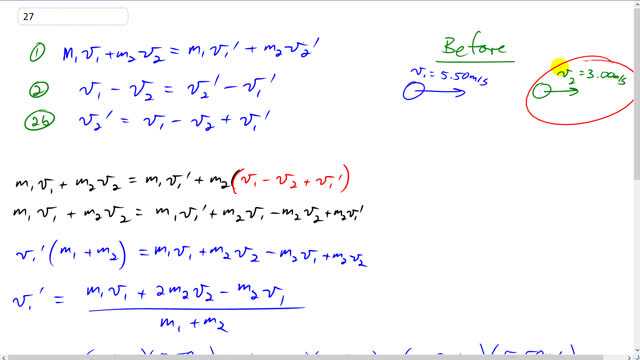
A 0.060-kg tennis ball, moving with a speed of 5.50 m/s, has a head-on collision with a 0.090-kg ball initially moving in the same direction at a speed of 3.00 m/s. Assuming a perfectly elastic collision, determine the speed and direction of each ball after the collision.

In order to watch this solution you need to have a subscription.
This is Giancoli Answers with Mr. Dychko. So before the collision of these tennis balls, we have this picture where the tennis ball that's behind is going at 5.50 meters per second and it's catching up to this other tennis ball that's in front of it going at only 3.00 meters per second. When they collide, the collision is elastic we are told so this formula applies v 1 minus v 2 equals v 2 prime after collision minus v 1 prime and conservation of momentum also applies. We are going to rearrange equation 2 and write it as v 2 prime because then we'll substitute for v 2 prime in equation 1 so that way we can reduce the number of unknown's there and then solve for the v 1 prime which will be the only unknown remaining after we substitute for v 2 prime. So we get this v 2 prime by moving this v 1 prime to the other side or adding it to both sides and then switching the sides around. So v 2 prime is v 1 minus v 2 plus v 1 prime. So we rewrite equation 1, version b, you could say, copying it but writing instead of the v 2 prime, writing v 1 minus v 2 plus v 1 prime there instead otherwise it's the same as equation 1. And we'll distribute the m 2 into the brackets there so m 2 times v 1 times negative v 2 times positive v 1 prime and then we'll collect all the v 1 prime terms together and there's two of them there's one here and there's one here and we'll factor out the v 1 prime so it becomes v 1 prime multiplied by m 1 plus m 2 and that's what I have here. And then we'll take this term to the other side and this term to the other side as well so this m 2v 1 becomes negative as shown here and this m 2v 2 becomes positive and switch the sides around as well so we have this unknown v 1 prime on the left and then divide both sides by m 1 plus m 2 and then that's all for v 1 prime. And then we plug in numbers to get our answer; that's 0.060 kilograms times 5.50 meters per second— that's the mass and velocity of the faster ball that's lagging behind and catching up— plus 2 times 0.090 kilograms times 3.00 meters per second minus 0.090 kilograms times 5.50 meters per second divided by the sum of the masses and that gives us 2.50 meters per second and that's a velocity so this is to the right; the first tennis ball is gonna be going at 2.5 meters per second to the right after the collision. v 2 prime we know from here is v 1 minus v 2 plus v 1 prime so we just figured out v 1 prime so we substitute in these two things given to us in the question; 5.50 meters per second minus 3.00 meters per second plus the 2.50 meters per second we just figured out that gives us 5.0 meters per second to the right.
wouldn’t eq #2 be v1-v2= -v1’ - v2’ ?
cause they’re going in equal but opposite directions?
They are going same direction, the one going 5.5 m/s is catching up to the 3 m/s ball.